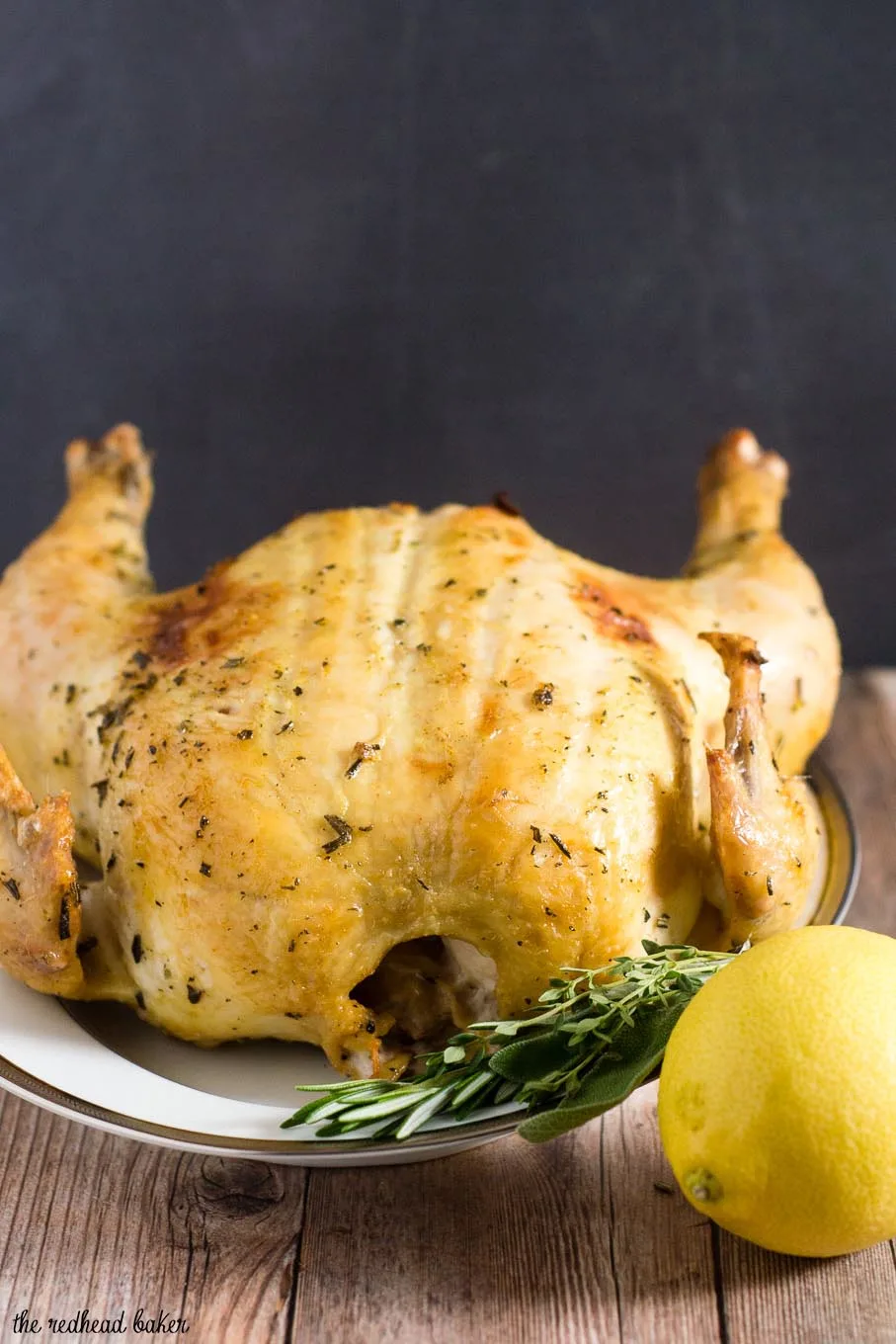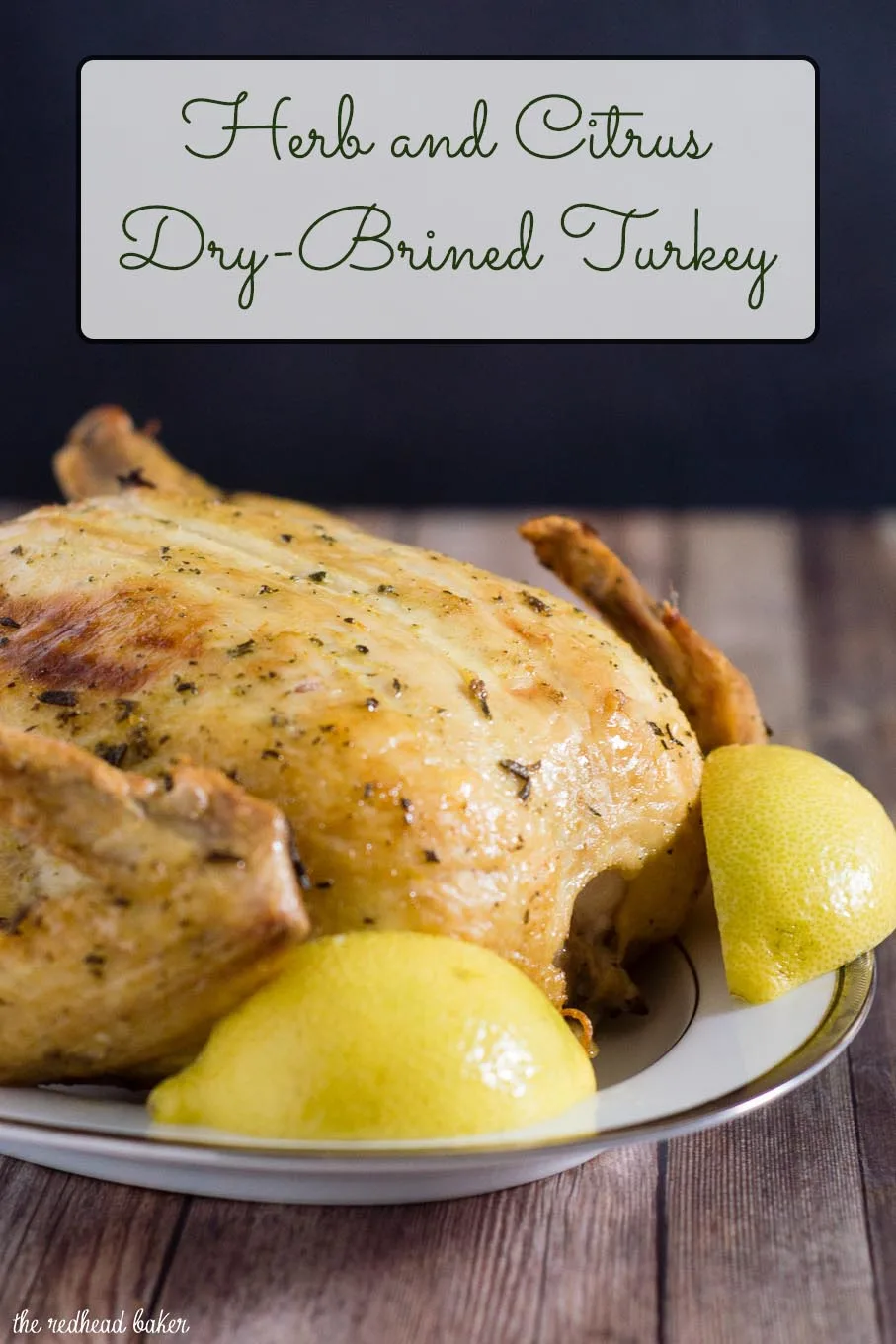Herb-and-Citrus Dry-Brined Turkey imparts all of the flavor of a traditional wet brine without the hassle and refrigerator space. So little effort for so much reward!

Years ago, I hosted my first Thanksgiving, and happened upon a recipe for a brined turkey. I'd never heard of brining before, but it sounded like a delicious way to impart flavor to the bird. After taking a bite of that turkey, I was offically on the brining bandwagon, and wet-brined my turkey every year for 6 years straight. Even my mother, who claims to not like turkey, loved it.
But wet brining is labor intensive, and finding a vessel big enough to hold all that brine as well as the bird in your refrigerator takes up a LOT of real estate, at a time when you're planning a feast that requires a lot of groceries, most of which need refrigeration as well.

A few years ago, I heard about dry-brined turkey. The concept isn't too different from traditional wet brining. Salt is used to draw moisture out of the turkey. As the moisture absorbs back in, it takes flavor with it. In wet brining, the salt and flavor are both in the brining liquid.
In dry-brining, the salt and flavor are applied directly to the turkey's skin. It still requires refrigeration, but takes up much less space. The salt mixture doesn't require cooking like most traditional wet brines do.

I think dry brining imparts MORE flavor than wet brining does. My cider-wet-brined turkey was delicious, but didn't have that strong flavor from the brine. In this turkey, you definitely taste the herbs and the citrus.
It's just so easy to make a dry-brined turkey, and with better results, well, it's a no-brainer for me. I'm now on the dry-brining bandwagon! There's some debate about whether or not you can make gravy from a brined turkey. I think it depends. If you want to try, taste the drippings before adding them to your gravy. If they are incredibly salty, add them only sparingly and discard the rest. Or use only the fat from the drippings.


Herb-and-Citrus Dry-Brined Turkey
Ingredients
- 13- pound fresh turkey
- 5 tablespoon kosher salt
- 2 sprigs rosemary, leaves only, plus more for roasting, 5-
- 2 sprigs thyme, only, plus more for roasting
- 4 leaves sage, plus more for roasting
- 2 lemons
- 1 naval orange
- 4 tablespoon unsalted butter, softened
Instructions
- Remove the neck and giblets from the cavity of the turkey. Discard or reserve for another use.
- Place the kosher salt, rosemary leaves, thyme leaves, sage leaves in the bowl of a food processor. Remove the zest of the lemons and orange, and add the zest to the food processor. Reserve 1 lemon and the orange for later. Pulse a few times until the mixture resembles coarse crumbs.
- Pat the turkey dry with paper towels. Place the turkey in a large brining bag. Rub the salt mixture all over the entire outside of the turkey. Wash your hands, then press as much air as possible out of the bag and seal the top.
- Place the turkey in the bag inside the refrigerator. Chill for 24 hours.
- The following day, remove the turkey from the brining bag and transfer to a cooking rack that’s set inside of a roasting pan. Let set at room temperature for 1 hour. At the 45-minute mark, preheat your oven to 425 degrees F.
- Rub the unsalted butter under the skin of the turkey. Cut the reserved lemon and orange into wedges, and place in the cavity of the turkey. Add the extra sprigs of rosemary, thyme and sage to the turkey's cavity.
- Flip the turkey, breast-side down. Place in the oven to brown for 30 minutes.
- Flip the turkey over so it's breast-side up. Reduce the oven’s temperature to 350 degrees. Cook for an additional 2 ½ hours, until the internal temperature of the bird (inserted into the thickest part of the thigh) reads 165 degrees. Be sure to check on it periodically, basting with the juices that accumulate in the bottom of the roasting pan. If at any time the bird begins to brown too much, tent it loosely with a piece of foil.
- When the turkey is done, carefully remove it from the roasting pan and transfer to a cutting board to rest for 30 minutes before slicing and serving.
Recipe by The Redhead Baker
Recommended equipment:

